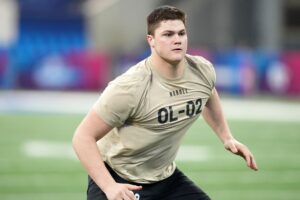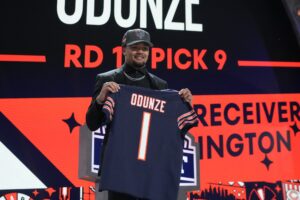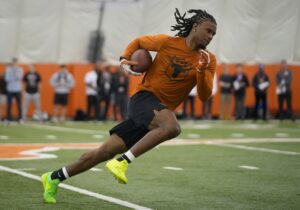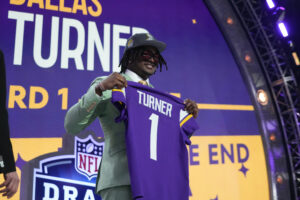New York is a luxurious, yet bustling city, in some regards epitomizing the personality of the dedicated and relentless worker America is personified by. For the Kansas City Chiefs to stride into MetLife Stadium and come out with a convincing win over the New York Giants, the Chiefs will need to personify the quintessential New York mentality. After a bye week, Andy Reid has the responsibility to bring his offense out with the same determinism they brought out against the New England Patriots in week one. Although the Giants stand at 1-8, behind a defense who is perceptively infighting, there are components of the intrinsic scheme that can be resurrected should the Giants play up to their talent. The Kansas City Chiefs week 11 scheme must be deterministic, assertive, and quick-witted to end any opportunity for the Giants to remember their winning methodology.
Kansas City Chiefs Week 11 Scheme Breakdown – The City that Never Sleeps
Demoralizing the Opponent by Determinism
The Chiefs offense functions through the run game and then options to the pass game. The Giants secondary in 2016 was prolific, deceptive, and manipulative. Landon Collins and Eli Apple were a formidable duo for everyone except the very best. However, fast forward a year and the Chiefs have a lot of advantages over the now disinterested secondary. Schematically, the very nature of the run attack the Chiefs launch ought to negate any emphatic pressure.
In 2016, the Giants stood on a predisposition of deceiving quarterbacks by shading corners with safeties. They forced short passes, which led directly to interceptions and turnovers all based upon the intelligence of defensive coordinator Steve Spagnuolo. In some regards, the base formation is reminiscent of the principles the Chiefs defense adheres to.
Not much has changed throughout the years. Ever since Spagnuolo operated with legendary rush end Michael Strahan, pressure has been the first point to success. Personnel has now put pressure in the hands of Jason Pierre-Paul (4.5 sacks) and Olivier Vernon (two sacks) coming off separate edges. Their order is chaos, which allows linebackers Jonathan Casillas and Devon Kennard to layer alignments to create multiple packages to blitz from.
Those multiple packages adhere to the trajectory of chaos Spagnuolo loves to create. By shifting linebackers and their coverage at the same time, quarterbacks have the propensity to miss alignments on split out options, such as a motioning Tyreek Hill. When operating at their finest, the physicality and athleticism of the Giants secondary may be one of the best schemes to beat the Chiefs breadth of motion calls.
However, this is where the Giants problems start and end. When pressure is not created, schemes are not imposing, and corners cannot efficiently shade coverage. The Giants have generated a mere 13 sacks, and if Mitchell Schwartz and Eric Fisher can protect the edges, other play sets begin to come into form. Giving up 4.4 yards per carry, the Giants interior gaps have also been innately weak. Hence, Kareem Hunt should have room to develop foresight for several explosive runs through the A and B gaps.
Furthermore, the secondary is also beginning to take plays off. Spagnuolo’s reliance upon the expressive athleticism of Janoris Jenkins, Apple, and company on the back end destroys his attack when they play lazy. In the cover two scheme, the safeties will shade behind blitzing linebackers, then release into the corner lanes to create pass disruption and obtain interceptions. Length, athleticism, and intelligence made this a pattern in 2016. In 2017, trust has been usurped by apathy.
Make no mistake, talent does not suddenly disappear. The Giants could still spend the day shutting down the outside receivers. Fortunately, the Chiefs do not often target deep in those lanes. When Alex Smith targets Demarcus Robinson, he tosses short, curl routes that are safe by design. Travis Kelce may struggle more – he will take on slot coverage – against more physical safeties.
Yet, if the Chiefs can embarrass the Giants early in the game, the secondary may quickly revert to the apathetic attack seen over the previous weeks. Hunt takes the emphasis to demoralize the Giants defense, which will open slot lanes for Kelce and Hill to run at will. If everything works well, this game could feature some of the most explosive passes from Smith all season.
Wit and Personality
The typically austere Chiefs defense has been, more or less, a disappointing gaff. After losing Eric Berry, a creative and dominating captain has failed to step up. Identifiably by scheme point, the two players who can take on more wit and personality to beget second half success are Ron Parker and Reggie Ragland.
With Berry, Parker and Ragland can play at an average level without concern – they fit their role quaintly. However, without Berry, Parker needs to command the secondary, play faster than receivers, and Ragland needs to take on blocks with an unnatural aggressive shrug. If those two expand their play, the Chiefs defense will see some intrinsic improvement.
However, against the New York Giants, the Chiefs defense will be facing a depleted offense thanks to an experimental run game, a depleted crew of receivers, and veteran Eli Manning spending more time on his back than upright. The meta temptation would be to slump. If laziness occurs even in a win, the Chiefs defense is setting up an objectively detrimental precedent for the second half of the season.
The Giants rush attack is experimental, but lively and poignant once Orleans Darkwa and Wayne Gallman begin exchanging carries. Darkwa is chugging along for 5.1 yards per carry, while Gallman has 4.3 yards per carry. However, those stats ignore the complete inefficiency in play call.
Dynamic wide receivers Odell Beckham and Brandon Marshall are on the injured reserve and Sterling Shepard is slipping in and out of injury, making the pass attack a circus. Manning is boxed into a corner, forced to stare Evan Engram down on short routes, and then gets sacked any time he attempts a developed five-step drop.
Thus, the rushing attack’s marginal success is ineffective at setting up anything. Head coach Ben McAdoo has pivoted, twisted, and placed duct tape everywhere to no avail. He is painfully determined in play call, no matter if the plays are failing. The Giants attack on the first two drives will be their pattern of attack throughout the entire game, good results or bad.
The responsibility then falls on the pass rush to get off the ball quickly, and embarrass the Giants offensive line. Analyzing the front five, none have the technique or veteran prose to stop Dee Ford, Tamba Hali, or Justin Houston throughout the game. Even if Ereck Flowers comes out with a technical plan to stop Hali initially, Hali is veteran enough to develop a second quarter game plan to battle and get sacks. There are no excuses for the Chiefs pass rush in week 11. They must show why they have been paid.
The other problem with a depleted pass attack for the Giants is the fact that if they no longer have tight ends to stay in and help, they are forced to be functional receivers. Allen Bailey and new signee Cam Thomas (after Roy Miller was released due to Domestic Battery charges) can rotate to force interior double teams. Therefore, neither tackle will have a guard to help against twists and stunts from the outside pass rush. If the Chiefs play up to their demands, this can be a multiple sack game.
Another factor that has delineated the Giants opportunity in the run game is the fact they spend most of the game behind. In McAdoo’s mind this indicates pass no matter the success of Darkwa. The offense can help immensely by getting ahead early and throwing McAdoo into an internal spiral.
All being said, McAdoo is most likely to recognize the anemic Chiefs rush defense, which speaks to the need for Ragland and Derrick Johnson to step up into the gap and take the onus of stopping run plays. Darkwa has had most of his success on cut back runs that target the exterior lanes. His rushing emphasis carries the ability to break explosive runs just outside of the tackles. Gallman has modeled the same style of success.
The success of the Giants rush attack is indicative of the athleticism in both running backs. They suffer when attacking through the help of guards, thus speaking to the weak state of the offensive line. When scheme, motion, and alignment create open outside lanes for the running backs, they succeed. However, when they run inside based on the ability of the Giants offensive line to pave the path, they fail.
Summarizing the Plan of Attack
The Chiefs offense will need to start by feeding Hunt the ball repeatedly due to two notions. First, the entire Chiefs scheme is developed from the onset of running successfully. Secondly, running the ball at a Giants defense prone to apathy will demoralize their will to win. The success of both notions will create explosive run plays, while opening deep routes for Kelce and Hill. Smith could be the most explosive he has been all season.
On the flip side, the Chiefs defense must play with more passion, specifically Parker and Ragland. Although the Giants offense has several issues as evidenced by their 1-8 record, precedent ought to be established off the bye week by taking advantage of that. Darkwa and Gallman create success on their own, and must be stopped by Ragland, Parker, and Johnson playing a responsible fit-to-run. Meanwhile, the pass rush will take the emphasis of building personality into the scheme. Putting Manning on his back repeatedly will be emblematic of the Chiefs ability to walk out of MetLife with a convincing win.
Main Image:






